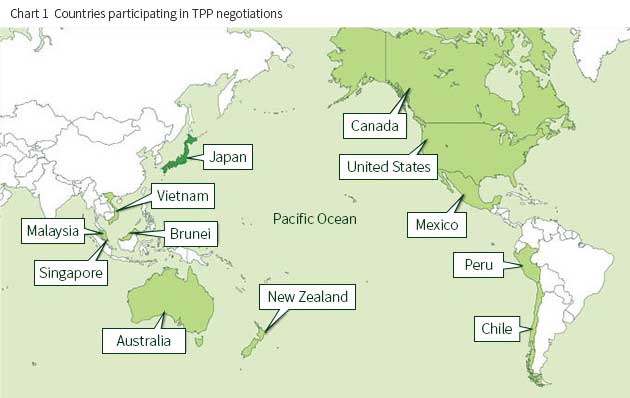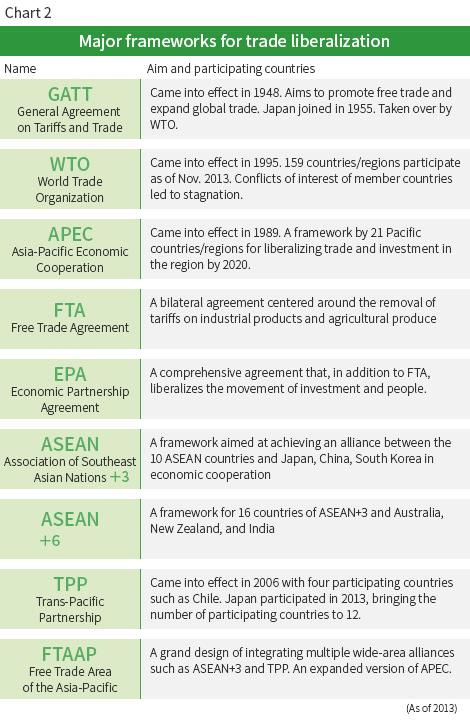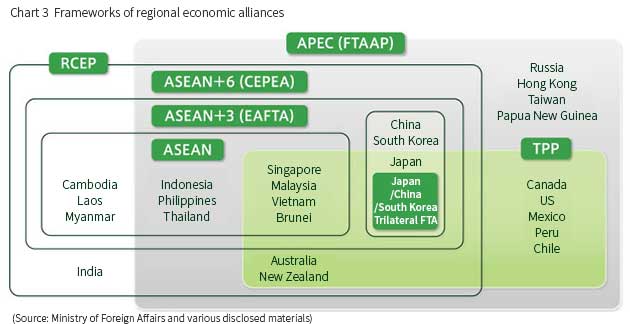In March 2013, Prime Minister Shinzo Abe officially announced his intention to participate in the Trans-Pacific Partnership (TPP) negotiations. Japan’s participation was later officially approved at the meeting of 11 participating countries that had already entered negotiations. The heads of state meeting held in Bali, Indonesia in October adopted a statement that said they would “proceed to resolve all outstanding issues with the objective of completing this year a comprehensive and balanced regional agreement” (Chart 1).
While Japan’s participation in the TPP is expected to lead to an increase in exports (of industrial products including automobiles and trucks) within the TPP zone and to the US in particular, it is also said to raise concerns of a negative impact on Japan’s agriculture industry due to a rise in imports of cheap agricultural products as well as threatening the safety and security of food and medical areas due to deregulation. Let’s take this opportunity to run through the basic knowledge about the TPP and examine the major arguments concerning the negotiations.
What is the TPP in the first place?
The TPP (Trans-Pacific Partnership) is an EPA (Economic Partnership Agreement) and a free trade agreement aiming to eliminate tariffs on imports and exports as much as possible and unify or harmonize the standards of goods and services as well as the various systems of the countries in the APEC (Asia-Pacific Economic Cooperation) zone in order to further liberalize the movement of goods, services, capital (funds), and labor within the zone, its core being the Asia-Pacific region. The reason why the TPP has attracted such attention is because it aims to achieve a level of liberalization that is higher than that of conventional EPAs and FTAs under the leadership of the United States in a broad area of Asia and the Pacific.
Initiatives for trade liberalization to vitalize trade with certain countries and regions include the FTA (Free Trade Agreement) and EPA (Economic Partnership Agreement). An FTA is an agreement mainly to mutually reduce or remove the barriers to the trading of goods, such as tariffs and import volume restrictions. On the other hand, an EPA is an agreement that covers not only the trading of goods but also the expansion of a broad range of economic activities, including the movement of services, capital, and labor, and the protection of intellectual property rights.
Then, what is the difference between the TPP and conventional FTAs or EPAs?
The first difference is that, while conventional FTAs and EPAs limit their member countries to the initial participant countries of the negotiations even though they aim at free trade between a certain two countries or within a region, the TPP does not limit participating countries but ultimately aims to achieve liberalization in all 21 member countries and regions of APEC.
In fact, ASEAN+3 (Japan, China, South Korea) and ASEAN+6 (Japan, China, South Korea, India, New Zealand, Australia) aim to incorporate all APEC member countries in the future. The ultimate goal is to integrate APEC into one free trade zone (FTAAP).
The second difference is that the TPP is a comprehensive agreement that includes not only eliminating tariffs on goods and liberalizing the trade of services, but also creating common regional rules for other areas (e.g. investment, competition, intellectual property, government procurement) and new areas (e.g. the environment, labor, cross-sectional matters).
The greatest characteristic of the TPP is that it aims for a 100% removal of tariffs on imports toward the goal of “liberalization without exceptions.” Based on this characteristic, the TPP can be considered as a complete form of FTA that aims for global liberalization of trade in a broad range of areas. Several things to note are that, while the WTO, in which 159 countries participate, negotiates the reduction of domestic agricultural subsidies based on strict rules, the TPP neither has rules for agricultural subsidies nor carries out any negotiations for reduction, and that many of the TPP participating countries anticipate increases in exports to the US market.

Why are these trade liberalization initiatives taking place in the international community?
Amid the Great Depression of the 1930s, the UK and France differentiated between the countries in their own economic zones, which included their colonies, and the rest of the world, and set high tariffs on countries outside their economic zones. This pervading protectionism led to the expansion of the Great Depression. It is said that, as many countries later rushed to adopt a more protectionist stance, economic friction and political conflict intensified, which partly contributed to the outbreak of WWII.
Out of regret for such developments, the two major countries of the US and the UK already led a plan during the war to institutionalize the global economy under free trade (the Atlantic Charter), which in 1948 culminated in GATT (General Agreement on Tariffs and Trade), centered around capitalist countries. Triggered in part by the collapse of the Soviet Union in December 1991, the WTO (World Trade Organization) was established in 1995 under the Uruguay Round, the multilateral trade negotiations that were carried out under GATT, to govern the new free trade system. The WTO is an international organization for maintaining and promoting free trade both in name and reality, incorporating GATT and including various agreements that stipulate the liberalization of the trading of services and the protection of intellectual property rights (Chart 2).
Multilateral trade negotiations called the Doha Agenda (or more widely known as the Doha Round) started in 2001 under the WTO. However, they have not yet concluded as there have been conflicts in eight areas between the group of developed countries and the group of developing countries. The interests of each country became complex under the WTO, making it difficult to finalize the negotiations. In particular, as a result of repeated interruption and resumption of negotiations due to conflicts between developed countries and the rapidly emerging countries (e.g. China, India, Brazil), the negotiations collapsed in 2008. Today, the negotiations have effectively been halted (for reference, member countries currently number 160 due to the recent approval of the membership of Yemen).
Subsequently, when the Director-General of the WTO switched from Mr. Pascal Lamy of the EU to Mr. Roberto Azevedo of Brazil, the negotiation areas were narrowed from the previous eight areas to three, which include agriculture, finally leading to a partial agreement on December 7 this year.
Due to such developments, FTAs and EPAs have come to attract more attention than the WTO in recent years. Unlike the WTO, which has many member countries and is failing to succeed in negotiations, FTAs and EPAs can be implemented in a short amount of time if the parties concerned reach an agreement. They also enable flexible agreement on the details of liberalization, such as exempting certain items. Such advantages have led to the recent surge in FTAs and EPAs.
The TPP originates from an FTA that came into effect in 2006 between the four countries of Singapore, Brunei, Chile, and New Zealand. It was called the P4 at the time. In fact, there had previously been a plan to conclude a P5, an FTA by five countries including the US, in around 2001, but due to the withdrawal of the US, it became the P4. The TPP attracted attention in 2008 when the US announced that it would participate in negotiations to establish the TPP based on the P4. In 2010, eight countries, which included the P4 countries, the US, Australia, Peru, and Vietnam, started negotiations. Malaysia, Mexico, and Canada later joined the negotiations, with Japan officially participating in July 2013, making the number of negotiating countries 12. If the TPP comes into effect, it will realize a new trade framework in the Asia-Pacific region, which is expected to further enhance the growth potential within the region. In addition, according to newspaper reports dated November 29, 2013, South Korea plans to participate in TPP negotiations.

The greatest economic advantage of Japan participating in TPP is, in the long term, the improvement of export competitiveness due to the drop in distribution costs of industrial products produced in the region. This is a matter of course if tariffs imposed each time a product is moved beyond borders become zero. Furthermore, if various standards are unified and mutually approved between the countries of the region, it will facilitate exports and local production. In other words, cost reduction across the supply chain can be expected since components produced in different countries in the region can be mutually supplied without tariffs. The advantage will be greater if countries in Southeast Asia, where thousands of Japanese companies operate, join the TPP.
On the other hand, there will also be disadvantages of participating in the TPP. Tariffs on the five key areas of rice, sugar, dairy products, beef/pork, and wheat were not removed under the EPAs that Japan has individually concluded with 13 different countries. However, tariffs may be significantly removed in all or many of these items under the TPP. If, in the TPP negotiations, tariffs are not removed from 586 items of these five areas, or 6.5% (agricultural items) of the 9,018 items subject to trade, the trade liberalization ratio will be 93.5%, a far cry from the 100% liberalization that the TPP negotiations target. Some view that, if the TPP were to aim for an FTA with the highest ratio of liberalization, at least 98% of liberation will be necessary, as I will mention later. In any case, the background to this is the discussion of how to view Japan’s food self-sufficiency. This is the reason why discussions in Japan on TPP participation are based on a paradigm of industry vs. agriculture.
Agricultural groups that are currently against Japan’s participation in the TPP claim that participation in the TPP will destroy Japan’s agriculture. Is this true?
The principle in TPP negotiations is to remove all tariffs regardless of the area. However, all participating countries have their own “sanctuaries” that they hope to exempt from liberalization from the perspective of protecting domestic industries. For example, the US is against tariff removal on sugar, while Canada is against elimination on dairy products. Japan intends to demand tariffs to be maintained on its “key five areas” of rice, sugar, dairy products, beef/pork, and wheat. Some view that around 98% liberalization will ultimately be demanded in TPP negotiations. If the total 9,018 items were 100%, this will mean that 2%, or around 180 items will be exempt from liberalization. If this will be the case, rice, which is the collective term for 58 items including unhulled rice, hulled rice, polished rice, and rice flour, will be exempt from liberalization without difficulty.
I personally think that the stance the Japanese government should take is to seek both the maintenance/expansion of free trade and the protection of Japanese agriculture. Japan’s agriculture is generally viewed as having high production costs and weak international competitiveness due to segmentalization of farmland of rice and other grains suited for large-scale production by the post-war farmland reform. On the other hand, farm produce that is not suited for large-scale production, such as fruits and vegetables, are highly valued abroad, and Japan also has an established reputation for its high level of agricultural techniques. Some view that trade liberalization of the agricultural area is a golden opportunity for Japan’s agriculture to transform its high-cost structure and acquire export competitiveness that can offset the effects of liberalization. However, I believe that it is desirable to maintain at the smallest cost possible a system that can secure the minimum food supply without destroying Japan’s diverse food and agricultural varieties. The Japanese government is required to work out a long-term and robust policy that focuses on the continuation of Japan’s agriculture instead of focusing on maintaining the employment of farmers. To that end, the government is required to develop specific measures and rules, such as, for example, prohibiting the conversion of farmland for cultivating agricultural products to residential land, instead of using abstract expressions such as “improvement of competitiveness.”
It has become the global standard to protect items that really need to be protected by subsidy and not by tariffs. The time has come when the government must get down to structural reforms of agriculture in order to maintain and expand free trade and protect agriculture at the same time. Such reforms include announcing a new protection system to replace tariffs. The system of individual (household) income support for agriculture under the administration of the Democratic Party, which was conditional upon acreage reduction (production restriction) and criticized for being a dole-out policy, was renamed the Program for Stabilization of Management Income under the Abe administration of the Liberal Democratic Party. It may be converted into a system where farmers can produce farm produce as they wish and receive subsidy according to their contribution to environmental protection measures, such as facilitating the survival of various organisms and reducing the emission of CO2.
When discussing Japan’s participation in the TPP, it is important to also take into consideration the TPP’s political and social significance in the Asia-Pacific region. This is because the TPP has a large political and diplomatic impact even though it is primarily a framework of economic partnership agreement (EPA).
Other free trade agreement frameworks that are being promoted in the Asia-Pacific region include ASEAN+3, which encompasses the 10 ASEAN nations and Japan, China, and South Korea, and ASEAN+6, which adds Australia, New Zealand, and India to ASEAN+3 (Chart 3).
From an economic perspective, a reference point for determining which of the three frameworks Japan should place emphasis on would be how much GDP will grow by joining the framework. According to an estimate announced by the Japanese government ahead of its decision to participate in TPP negotiations, Japan is expected to gain 4 trillion yen from ASEAN+3, 5 trillion yen from ASEAN+6, and 3 trillion yen from TPP. This may seem that Japan should choose ASEAN+6, but the Japanese government anticipates that the outcome of the TPP negotiations would have a positive impact on the developments of negotiations of the other two.
Then, let’s examine the three frameworks from the perspective of which countries are participating and which country is leading the discussions. The core country of both ASEAN+3 and ASEAN+6 is China, which is expected to see continued market expansion, while the US is not participating. On the other hand, TPP is led by the US but China is not participating.
Which of the three frameworks Japan places emphasis on is deeply linked to the struggle for leadership between the US and China, the two major countries of the Asia-Pacific region, and Japan’s position within the struggle. With territorial disputes and unprecedented risk factors in national security, it is essential for Japan to maintain and reinforce its alliance with the US. From this perspective, it might be necessary for Japan to join the TPP.
Japan, which is among the world’s largest economic powers and claims to be a trading nation, has a long history of leading the world’s free trade system after the war along with the US and the EU. Not participating in the TPP may not be an option for Japan if it wishes to remain a key player. This is my opinion.
What is especially important is that we can anticipate a strategically favorable cycle of achieving a greater degree of liberalization in the FTA negotiations with the EU and with China and South Korea, triggered by the increase in items subject to liberalization and the rise in the degree of liberalization in the TPP negotiations.

(This column is as of 2013.)